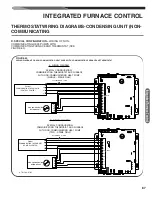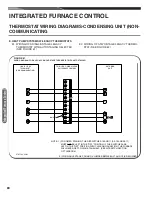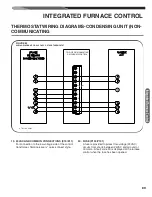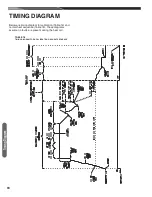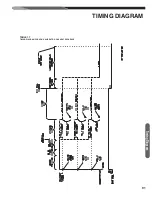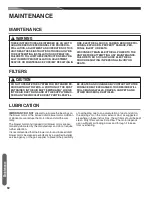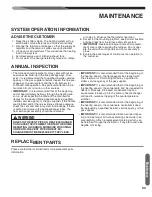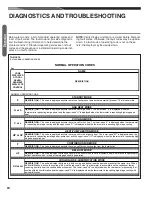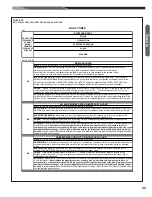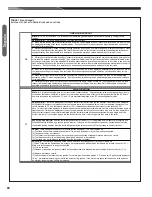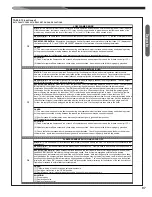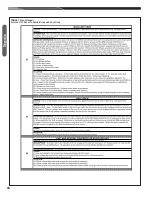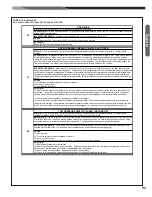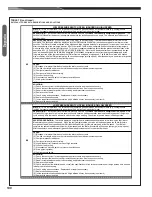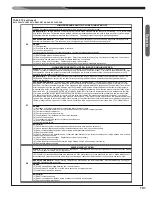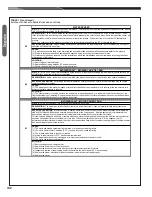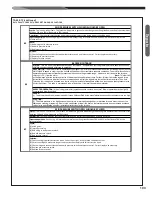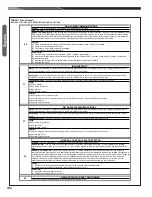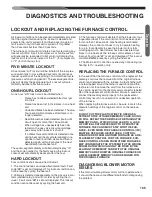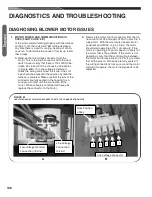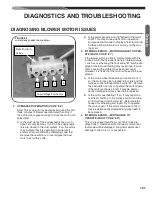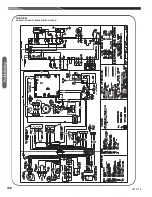
101
TABLE 19 (continued)
R97V FAULT CODES WITH DESCRIPTIONS AND SOLUTIONS
(4) Faulty control board (inducer relay).
(5) High altitude kit not installed in areas of high elevation.
STATUS:
This is a critical fault. The furnace will not operate in gas heat modes but all other modes (e.g. cooling) should
function if present simultaneously with a heating call (e.g. defrost call in dual-fuel mode). If this fault is experienced during high
heat operation and the low pressure switch remains engaged, the furnace will switch to low fire heat and continue to run (if
possible) to try to satisfy the thermostat.
DESCRIPTION:
This fault indicates that the high pressure switch is open when the inducer is energized at high speed. This
fault can be displayed any time during the heat call except during low heat call and only
after
the pre-purge and blower on
delays are complete.
CAUSE:
(1) Blockage or improper termination in either the inlet or exhaust vents.
(2) The flue vent length and/or number of elbows exceeds the maximum number specified.
(3) Faulty or disconnected inducer.
SOLUTION:
(1) Replace high pressure control (switch).
(3) Check wiring and connections. Replace and/or repair as necessary.
(4) Check for proper venting and terminations as defined in the furnace installation instructions.
HIGH PRESSURE SWITCH OPEN, INDUCER ON HIGH SPEED
(4) Abnormally high negative pressure present on vent system without inducer running.
SOLUTION:
(1) Check the vent system for blockage and proper termination and repair as necessary.
CAUSE:
55
HIGH PRESSURE SWITCH CLOSED, INDUCER OFF
STATUS:
This is a critical fault. The furnace will not operate in gas heat modes but all other modes (e.g. cooling) should
function if present simultaneously with a heating call (e.g. defrost call in dual-fuel mode)
.
DESCRIPTION:
The high pressure control (or switch) should not be closed when the inducer is not running. If it is, this is a sign
of a serious condition. The switch may be welded closed or purposely bypassed in the field. Before any heat cycle can begin,
the pressure switch is tested to make sure that it is opened. The switch is ignored except in gas heating modes.
(1) Faulty switch.
(3) Loose or faulty wiring.
57
(9) Replace the pressure switch.
(3) Water sensor has been removed.
(1) Repair or replace wiring.
(2) Repair connections or replace wiring or sensors or controls as necessary.
(3) Replace missing water sensor.
(3) Repair or replace inducer and/or inducer wiring and/or electrical connections.
(4) Replace control board.
(5) Check elevation of the installation and consult the specifications for the furnace to determine if a high altitude kit is needed.
Install proper kit as necessary.
(6) Check wiring and connections. Replace and/or repair as necessary.
(1) Wiring has been damaged between the control or sensor.
(2) Connection of P4 at the IFC or at the water sensors is not properly made.
(7) Replace hoses as necessary.
(8) Insure proper termination and determine if high altitude kit may be necessary (see item 4)
(2) Check the specification sheets and/or installation instructions. Remove excess venting.
58
CAUSE:
SOLUTION:
STATUS:
This is a critical fault experienced by the furnace. The furnace will not operate in gas heat modes but all other modes
(e.g. cooling) should function if a call is present.
DESCRIPTION:
The IFC cannot detect electrical continuity between pins 1 and 2 of connector P4 of the furnace control. The
IFC looks for continuity between these pins to determine if the water sensors (2) are present in the circuit. When both sensors
are present and properly connected and wiring is not damaged, there should be elelctrical continuity between these pins.
EXPECTED OPERATION:
No gas heating operation can proceed and the fault is displayed. All other modes (e.g. cooling) of
operation should operate as normal.
EXPECTED OPERATION:
There will be no other operation than displaying of the fault code and diagnostic messages to the
homeowner and technician. The fault code is only present during a heat call before pre-purge begins.
(2) Pressure switch physically bypassed in the field.
(2) Remove bypass and restore correct operation. Determine reason for bypass (e.g. vent length too long) and correct issue.
Notify homeowner and proper authorities of illeagle tampering if necessary.
(6) Loose or faulty wiring.
(7) Disconnected, blocked, split or cut pressure switch hoses.
(8) Wind gusts (sporadic).
(9) Faulty pressure switch.
EXPECTED OPERATION:
(1) DISPLAYED BEFORE HEAT IS ESTABLISHED: The IBM (Indoor Blower Motor) will not be
energized. The fault code will not be displayed until the IDM (Induced Draft Motor) has been energized for a minimum of ten
seconds. The IDM will remain energized at the high speed (high speed is default pre-purge speed) for a period of five minutes
after the beginning of the pre-purge attempt. After five minutes, the IDM is de-energized and second attempt at pre-purge is
made (as long as the heat call is still present). This cycle is repeated indefinately until either the pressure switch closes or the
heat call is lost. (2) DISPLAYED AFTER HEAT IS ESTABLISHED - If this fault is displayed after heat is established, the IDM
will remain energized at high speed and the firing rate will drop to low stage provided the low pressure switch remains closed.
The IBM will energize at, or switch to, the low-fire rate (also provided the low pressure switch remains closed). Low heat is
provided until the heat call ends or the high pressure switch closes. If the high pressure switch closes, the heat rate and blower
speed will be adjusted to the correct (higher) rate required by the thermostat and the IDM will remain energized at high speed. If
the low pressure switch also will not remain closed, operation will be as described under fault code # 46 ("LPC OPEN") above.
WATER CIRCUIT OPEN
Dia
gn
ost
ics

